Developing One of the World’s Largest Countries
RAILWAYS OF THE WORLD - 15
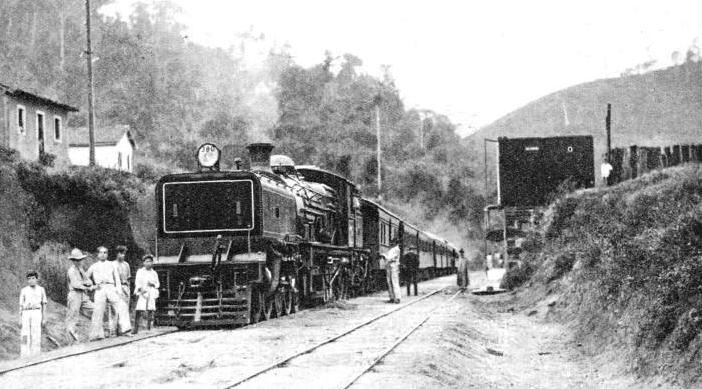
THE LARGEST BRITISH-OWNED RAILWAY IN BRAZIL is the Leopoldina Railway, which control 1,918 miles of metre-gauge track. Its lines serve the three states of Rio de Janeiro, Minas Garaes, and Espirito Santo, and the company is an amalgamation of thirty-eight small railways. The illustration shows one of the articulated “Beyer-Garratt” locomotives on its lines.
THE vast area covered by the United States of Brazil has provided extremely difficult problems for railway engineers of various nationalities. Brazil is larger than the continent of Australia, as it comprises nearly 3,300,000 square miles; it occupies nearly one-half of the continent of South America, and, according to an estimate of the population in 1934, it is inhabited by forty-five million people. In several ways it differs from the rest of South America. The language is not Spanish, but Portuguese, as the country was colonized by the Portuguese.
It became an empire in 1822 under Pedro I. His son, Pedro II, was dethroned in 1889, when Brazil became a republic. There are twenty States, one federal territory and one federal district.
Railway development has been concentrated in the coastal regions, and the total mileage is 24,630. There is no unified system linking all parts of the country, and the ownership and operation of the railways are complicated. Large areas are without railways. The Amazon and other rivers provide over 30,000 miles of navigable waterways, and fifteen of the twenty States are on the coast. Railways have developed chiefly in the south-eastern States to aid transport in the fertile but mountainous country not served by navigable rivers. Some lines are worked by companies, a number of these being British concerns, under various concessions and leases from States and from the Federal Government, and others are worked by either the States or by the central Government.
Rio de Janeiro has a population of 1,800,000, and is the chief railway centre. At one time the city was fever-ridden, but it has been so improved that it now claims to be one of the healthiest in the tropics. It stands on the south shore of the Bay of Rio de Janeiro, one of the loveliest harbours in the world. Across the entrance to the bay is the town of Nictheroy, capital of the State of Rio de Janeiro, and a residential town for workers of Rio de Janeiro. Ferries ply from one town to the other, and the Leopoldina Railway runs round the bay in the form of a horseshoe, linking the towns and serving various suburbs.
The Leopoldina Railway, the headquarters of which are in Rio de Janeiro, is one of the most interesting lines in South America. It operates 1,918 miles of metre-gauge track, is the largest railway of that gauge in Brazil, and is the biggest British-owned railway in the country. It is an amalgamation of what were originally thirty-eight different railways. The railway has a heavy suburban traffic in one of the most populous cities in the southern hemisphere, and it carries passengers and goods up and down mountainous country where gradients are severe and curves are acute. This line serves the three states of Rio de Janeiro, Minas Geraes, and Espirito Santo.
The only parts of the system lying in fairly level country are those round the Bay of Rio de Janeiro, and a length of 200 miles on the main line from Rio de Janeiro to the seaport of Victoria. Even on this line the gradients are heavy for the remaining 196 miles to Victoria. The principal terminus of the railway is the Barao de Mana Station at Rio de Janeiro, which was completed in 1926, having been built to replace an older station which traffic had outgrown. So great is the suburban passenger traffic from the terminus to Penha and to Merity, a distance of twelve and a half miles, that the track for this section is quadruplicate, the daily service being 128 trains of ten coaches hauled by tank locomotives. The total number of trains dealt with at the terminus is 154. The largest signal-box consists of a single frame of 180 levers. The eight platforms range in length up to 820 ft.
Running north and north-east from Rio de Janeiro, the network of lines covers a large area. The most northerly point is Caratinga, 394 miles distant, while that to the north-east is Victoria. Express trains take about fifteen hours to cover the 332 miles to the town of Raul Soares, a station on the northern line sixty-two miles short of Caratinga, and about twenty-two hours for the 396 miles to Victoria. These times are good in view of the severe gradients, and the numerous stops necessitated by single-line working, except in the suburbs.
Rack Locomotives Employed
On the route to Raul Scares, the Serra has to be climbed, rack locomotives being employed. The night mail averages twenty-two miles an hour over the whole distance to Raul Soares, although there are about twenty-two stops, and although the train has to be hauled up to a height of 2,600 ft in less than four miles by rack locomotives. On the run to Victoria even the easiest stretch has gradients of 1 in 70. As this section is subjected to floods, and the track is for the most part earth ballasted, the maximum speed is fixed for reasons of safety at forty-four miles an hour. Dining-cars are run on the day trains and sleeping-cars on the night trains.
As with the São Paulo Railway the Leopoldina Railway has to overcome the abrupt rise of the precipice-like ridge which separates the fertile uplands from the coastal region. The São Paulo Railway trains arc pulled up by steel cables; the trains of the Leopoldina Railway, which are of metre gauge, as compared with the 5 ft 3-in gauge trains of the main São Paulo line, conquer a very similar climb on two of the three main routes, in one instance by the rack principle and in the other by adhesion.
The Leopoldina Railway Company inherited a system so complicated that it would be wearisome to describe in detail, and so variegated in rolling-stock and design, that the unification of all the little lines into a complete system of a uniform gauge has been a triumph of organization.
The oldest of the lines incorporated in the Leopoldina Railways is that from Mauá, on the Bay of Rio de Janeiro, to the foot of the precipitous Petropolis Serra, a distance of ten miles. This line was opened in 1854. It is said to be the oldest railway in America south of the equator. The line from which the company takes its name, the Companhia de Estrada de Ferro Leopoldina, received a concession to build a railway to link a terminal of the Estrada de Ferro Dom Pedro II at Porto Novo do Cunha with the town of Leopoldina, authorization being granted in 1872. This metre-gauge railway operated in the fertile uplands, and built and bought other lines. As the gauge of the Dom Pedro II line was 5 ft 3-in, and the sending of goods to the coast involved the usual transhipment trouble due to a difference of gauges, the Leopoldina company bought a railway which ran to Nictheroy, opposite Rio de Janeiro. There was much construction in the ‘seventies, and by 1886 the company owned 1,330 miles of track. Later it experienced financial troubles, and after years of negotiations a British company was formed in London at the end of 1897. The new company took over the lines in 1898 and built and bought other lines to consolidate the whole system.
When the British company took the system over, the lines were in poor condition, because they had in the first place been built as cheaply as possible; and then, because of the financial plight of the various concerns, they had not been properly maintained. Most of the bridges and culverts were of timber, and these had to be replaced by steel and masonry structures; sections of line in hilly country, where wash-outs and land-slips due to the heavy rain were frequent, had to be protected by retaining walls and revetments. Much work had thus to be done to make the system efficient.
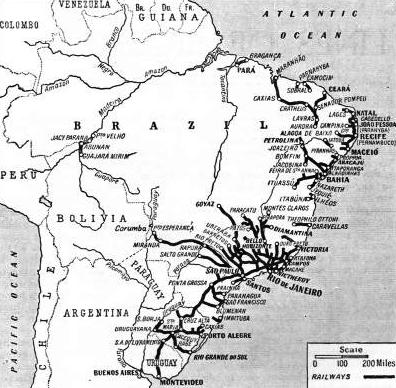
RAILWAY DEVELOPMENT IN BRAZIL, as this map shows, has been chiefly in the eastern coastal regions. The total railway mileage is 24,630. The lines are worked by private companies, the various States, or by the central Government.
One of the three main lines leads north from Rio de Janeiro through Petropolis, Entre Rios - a junction station for the Federal-owned Central Railway of Brazil, over a branch of which the Leopoldina Railway has running powers - and Ponte Nova to Raul Soares and Caratinga. This line runs out of the State of Rio de Janeiro into that of Minas Geraes. The second main line runs to the east of the first through the same two States up to Manhuassú. The third runs east of that through the State of Rio de Janeiro to Macahé and Campos and on to Victoria in the State of Espirito Santo. Lateral lines and branches connect the main lines.
The first two of the three main lines have to conquer the Serra that lies inland from the city of Rio de Janeiro. Except for that section which traverses the coastal plain, the Victoria line has to negotiate hilly country; gradients as steep as 1 in 33 and sharp curves are encountered. This line is operated by ordinary locomotives. On the two other main lines special methods have to be employed to deal with the Serra.
On the main line to Entre Rios and the north is a climb known as the Petropolis Serra, the foot of which is thirty miles from the Rio de Janeiro terminus. In a distance of three and three-quarter miles from Raiz da Serra to Alto da Serra the line has to climb from a height above sea-level of about 150 ft to 2,763 ft. There is one station on this incline at Meia da Serra about a mile and a half from the foot. The maximum gradient is 1 in 5¼ with curves of 343 ft to 982 ft radius. This section is laid on the Riggenbach system, described in the chapter “Rack Rail Locomotives”, which begins on page 804. It is operated by steam engines. Although not the steepest gradient operated by the Riggenbach system, it carries what is probably the heaviest traffic as, in addition to goods trains, twelve passenger trains are run daily in the winter and fourteen in the summer. Petropolis, a resort favoured by residents of Rio de Janeiro who wish to escape from the heat of the city in the summer, stands 2,600 ft above sea-level. Express trains from the terminus take one hour and forty minutes to cover the thirty-six miles.
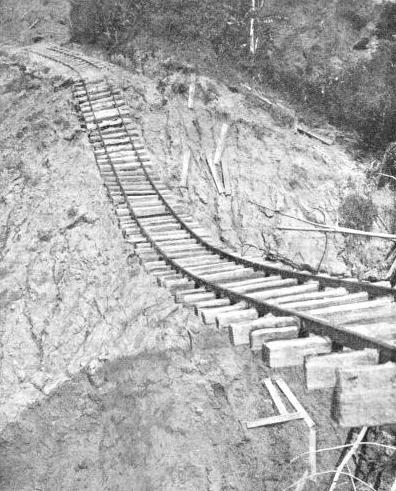 Practice has enabled the operation of these trains, which may be as long as fourteen coaches, to be as nearly perfect as possible. On reaching the foot of the climb each train is split up into sections of two coaches, each section being hauled up by one rack locomotive. Before the train arrives, rack locomotives are waiting on spur lines to pick up their two coaches. Only five minutes are allowed for the work of splitting up the train and getting the coaches on the move.
Practice has enabled the operation of these trains, which may be as long as fourteen coaches, to be as nearly perfect as possible. On reaching the foot of the climb each train is split up into sections of two coaches, each section being hauled up by one rack locomotive. Before the train arrives, rack locomotives are waiting on spur lines to pick up their two coaches. Only five minutes are allowed for the work of splitting up the train and getting the coaches on the move.
A WASH-OUT of track and embankment on the Araruama extension of the Leopoldina Railway. The damage was caused by heavy rains early in 1924. Torrential rains form one of the major problems that railway engineers must face in Brazil.
The rack engines on the Petropolis Serra include some built by the Société Suisse of Winterthur, which are super-heated, with a working pressure of 195 lb per sq in. They have a single rack wheel to engage the rack. For the descent there are Le Chatelier back-pressure brakes, and each engine has band brakes on the crank disk wheels, and a hand rack brake working on a cogwheel on the front wheel. The principle of the Le Chatelier brake is to suck in air during the descent, and to pump it into the steam pipes, where it accumulates and its pressure acts as a brake. The discharge of the air is arranged by a pipe, the valve of which is in the engine cab. The driver regulates the speed of the descent by this valve, which controls the pressure of the compressed air.
The second stiff gradient is that of the Friburgo Serra, on the second main line between Bocca do Matto and Theodoro de Oliveira. This gradient is less severe than the other, being 1 in 11, and is now operated by adhesion, although a central rail is used as a brake by descending trains. It is one of the most interesting examples of adhesion working in the world.
When the Brazilian engineers laid the track from Nictheroy they paused at the foot of this incline and considered a way to surmount it. An exceptional opportunity presented itself about 1872, when the Mont Cenis Tunnel, connecting France and Italy, had been completed, and the construction railway, operating on the Fell system, which had been laid over the mountains, was put up for sale. The Brazilians made an offer which was accepted, and the Fell railway was dismantled and shipped to Brazil. For some years this second-hand railway climbed the 1 in 12½ gradients which then existed on this section, but it did not give complete satisfaction. Ultimately the Baldwin Locomotive Company, of Philadelphia, supplied locomotives which were powerful enough to conquer the incline by adhesion, and at one time this section was the most severe in gradient of any trunk line operated by adhesion.
Except for the latest type of locomotive, the engines employed on this incline weigh about 44 or 46½ tons, and pull passenger trains weighing forty tons up the grade at an average speed of nine miles an hour. Goods trains of about the same weight as the engine are pulled up at a slightly lower speed. The total distance from Bocca do Matto to Theodoro de Oliveira is seven and a half miles, and the line has to climb from 787 ft to 3,543 ft. There are two stations on this incline, at Penna and at Registro. The most acute curve has a radius of 111½ ft, and curves of 131, 164, 197 and up to 328 ft are numerous. When the trains descend the load is ninety tons and the speed is nine miles an hour. A stop is made at Penna to change the engine central rail brake blocks, the wear of which is from one to one and three-eighth inches, according to the weight of the train.

A 4-6-0 PASSENGER LOCOMOTIVE on the Great Western of Brazil Railway. The railway company operates 1,082 miles of metre-gauge track and possesses 161 locomotives and several motor trolleys.
As the central brake gear was rigid with the frames, trouble due to fractures on sharp curves arose. A new locomotive was therefore designed by the company with a wheelbase of 9 ft 8-in. The central rail steam brake was re-designed and sprung from the engine frame to allow for irregularities in the track; also the weight on the driving-wheels was increased to bring the total up to 49 tons. This new locomotive was built by the North British Locomotive Company and the improvements included superheating, Lentz poppet valves, Walschaerts valve gear, and multiple valve regulator. Not only was greater safety ensured, but coal consumption was reduced by one-fifth.
In the interior about nine-tenths of the lines are laid in hilly country. Extensive cuttings have been found necessary, as the location of most lines is along the banks of rivers which flow down from the hills. Curves are numerous, for the lines twist this way and that to avoid as much climbing as possible.
The trains from the terminus at Barao de Maua Station proceed first over the four-track line through the suburbs to Penha and on to Merity station, twelve and a half miles from which the track is double, as far as Rosario. Hence the main line goes on in single track to connect with the original line which ran north from Mauá, on the northern shore of the Bay of Rio de Janeiro, to the foot of the Petropolis Serra. A line which runs in horse-shoe shape round the Bay proceeds from Rosario round to Nictheroy. The ascent of the three and three-quarter miles of the Petropolis Serra takes thirty minutes.

SUGAR-CANE forms a large part of the freight traffic carried by the Great Western of Brazil Railway. This illustration shows a British-built bogie sugar cane wagon with a capacity of 15 tons.
Petropolis, a thriving residential and manufacturing town of more than 40,000 inhabitants, is reached in one hour forty minutes from the Rio terminus. Until 1931 Raul Soares was the northern terminus, the distance being 332 miles, but an extension of about sixty-two miles was in that year opened to Caratinga. Raul Soares lies 961ft above sea-level.
For the first six miles of the extension the line runs through forest and across a plain, and crosses the River Vermelho by a reinforced concrete bridge. It then begins to climb, a gradient of 1 in 66 increasing to 1 in 40. Earthworks are heavy in this section, banks and deep cuttings being numerous. The summit level of the extension, 1,886 ft above sea-level, is reached five miles before Caratinga is approached.
A number of rivers had to be crossed, and British steelwork was used for the bridges. The building of the extension was divided into six sections, and the work was contracted out, The task of bringing up materials in the hilly country provided many difficulties. Material was carted in ox-wagons drawn by from six to twelve yoke of oxen, and the rate of transport of such vehicles was only seven or eight miles a day in good weather. When the rains set in, the mountain tracks became impassable, and the roads had to be improved to carry motor lorries so that the material could be delivered.
Because of the variety of the lines which form the Leopoldina Railway, the rolling-stock is still of a varied character, especially the goods wagons. In recent years modern vehicles have been introduced. There are seven railway shops in various parts of the system, and these carry out repairs and build coaches and wagons; there are also nine running sheds. A dining-car built at the Porto Novo workshops has a kitchen, ice chest, and the equipment for serving twelve passengers at a time. The body and underframe are of native timber, and are carried on steel bogies. A sleeping-car, accommodating sixteen passengers and a car attendant, has steel underframes. Coaching stock is equipped with electric light, water tanks, and hand and automatic vacuum brakes.
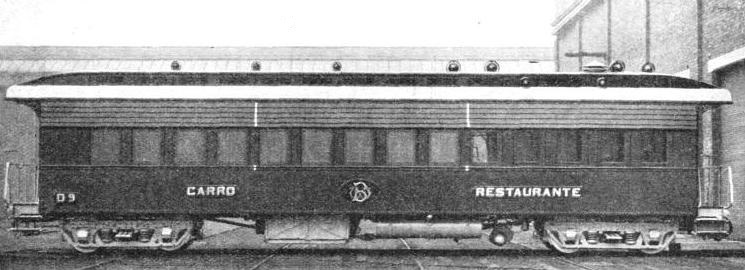
A FIRST-CLASS RESTAURANT CAR in service on the Great Western of Brazil Railway. This coach was constructed by the Birmingham Railway Carriage and Wagon Company, Ltd, at Smethwick, Staffordshire. The railway taps portions of the states of Parahyba, Rio Grande do Norte, Pernambuco and Alagoas.
Imported freight vehicles include a bogie insulated wagon for milk traffic and a twenty tons all-steel bogie covered goods wagon; because of the gradients every effort is made to keep the weight of such vehicles as low as possible. Special wagons for carrying sugar-cane have been built in the company's workshops. Sugar-cane is the heaviest item in the goods tonnage.
The Leopoldina Railway possesses about 300 steam locomotives, and the bulk of the traffic is hauled by three types, the “Mogul” (2-6-0), the “Consolidation” (2-8-0) and the “Pacific” (4-6-2), the “Pacific” being used on all heavy main line passenger work. These engines are suitable for running over difficult stretches of line.
The most powerful locomotives on the railway are two articulated “Beyer-Garratts”, which were designed for the line. These engines have a tractive effort at 75 per cent of the boiler pressure amounting to 29,330 lb, an increase of more than 80 per cent over the “Pacific” class, the diameter of coupled wheels being the same in both instances.

A 4-8-0 LOCOMOTIVE built by Sir W. G. Armstrong Whitworth and Co. (Engineers), Ltd., for the Great Western of Brazil Railway.
These “Beyer-Garratts” were built for hauling heavy night passenger trains between Campos and Victoria, a distance of 200 miles. (Campos is 170 miles from Nictheroy.)
The wheel arrangement is 4-6-2 + 2-6-4, and the locomotives have there-fore the same running characteristics as the “Pacifics” with the addition of 80 per cent in drawbar pull. The dimensions are as follows below:
Cylinders (4) .. .. .. .. .. .. .. .. 15½ x 22-in.
Coupled wheels, diameter .. .. 4 ft 2-in.
Boiler pressure, lb per sq in. .. 185
Heating surface, tubes .. .. .. . 1,546 sq ft.
firebox .. .. . 151 sq ft.
Total . .. .. .. 1,697 sq ft.
Superheater 335 sq ft.
Total . .. .. .. . 2,032 sq ft.
Grate area .. .. .. .. .. .. .. .. .. . 34 sq ft.
Water capacity .. .. .. .. .. .. .. . 3,500 gallons
Coal capacity .. .. .. .. .. .. .. .. . 4½ tons
Rigid wheelbase .. .. .. .. .. .. .. . 9 ft 6-in.
Total weight in working order .. 111½ tons
Tractive effort (75% boiler pressure) 29,330 lb.
Maximum axle load .. .. .. .. .. .. 10½ tons
The first 200 miles of the run from Nictheroy is through country which is low-lying and swampy. This section is subjected to floods caused by the heavy rains, and much ballasting and re-sleepering have had to be done. Beyond Campos the line encounters hilly country which becomes difficult at Itapemirim, 272 miles, the ruling gradient becoming 1 in 33 with many curves up to 269 ft radius. From Itapemirim to Virginia the line rises some 1,700 ft, and the gradient varies between 1 in 50 and 1 in 33, this bank being the most severe on the whole run to Victoria. The usual load for a “Pacific” engine up this bank is six coaches, but during the test run with one of the “Beyer-Garratts” the load was increased to ten coaches. The engine hauled this load up the bank between Itapemirim and Soturno, a distance of thirteen and a half miles, at the rate of about fifteen miles an hour.
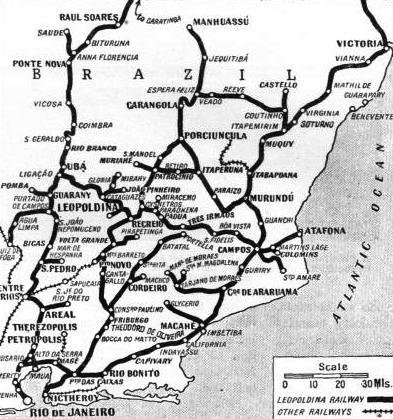
THE LINES OF LEOPOLDINA RAILWAY are indicated here. The company has its headquarters at Rio de Janeiro, and this railway handles especially heavy suburban traffic.
During 1933 the number of passenger journeys made on the Leopoldina Railway totalled 27,380,645. Most of this was for suburban traffic in the neighbourhood of Rio de Janeiro, this traffic amounting to 87·65 per cent. There are only two classes on the railway, the figures for the journeys being 8,787,235 first- and 18,593,410 second-class. The fares for second-class passengers on the suburban lines are extremely low, averaging 0·84 of a penny for a journey of seven and a quarter miles on one section. This rate does not pay, but the authorities have refused to allow the fares to be raised. Despite various difficulties the operation of the railway is highly efficient; every effort is made to maintain rolling-stock and track and to reduce expenses.
Goods traffic in 1933 amounted to 1,453,282 tons, the chief items of which were sugar-cane 429,156 tons, general goods 235,193 tons, coffee 170,649 tons, firewood 127,799 tons and sugar 115,310 tons. These figures of tonnage do not reflect corresponding proportions of value in receipts to the railway, as heavy and bulky produce such as sugar-cane is carried at an extraordinarily low rate. The restriction of the production of coffee, and the destruction of large stocks are economic factors from which the line has suffered.
Another important British-owned railway is the Great Western of Brazil Railway Company, which has 1,082 miles of metre-gauge track. This operates in country which is different in many ways from that served by the Leopoldina system. Despite its name, the railway serves the most easterly part of Brazil, the principal terminus being at Recife - better known to many readers as Pernambuco - the capital of the State of Pernambuco.
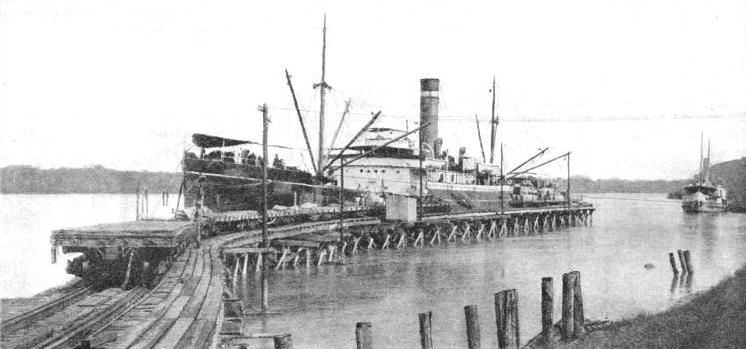
A TERMINUS of one of the world’s most remote railways, the Madeira-Mamoré Railway in the heart of the Amazon jungle. The line, connecting Porto Velho - seen above - and Guajara-Mirim, is 226 miles long.
Recife (Pernambuco) is the chief city of Northern Brazil, and is an important railway centre. There are various radiating lines, the most extensive of which strikes inland to the west to Alagoa de Baixo. Recife, with nearly 440,000 inhabitants, is the most important city in northern Brazil, and is in three parts, the first being Recife (the Reef), on a peninsula; the second, São Antonio, on an island; and the third, Boa Vista, on the mainland. Recife, sometimes called the “Venice of Brazil”, has an individuality of its own, and is 1,120 sea miles from Rio de Janeiro - about a third of the distance from Southampton to New York. As yet there is no communication by railway between Recife and the capital of Brazil.
Centred on Recife
Considering Recife as the hub of the Great Western of Brazil Railway, its extreme points are Natal, 262 miles north, and Maceió, 216 miles south. Another terminus is Cabedello, 145 miles north. In each section, the lines curve inland to tap the hinterland and do not follow the coast. Natal, with nearly 50,000 inhabitants, exports sugar, cotton and hides; Cabedello is the port of João Pessoa, a town of 95,000 inhabitants and the capital of the State of Parahyba. Maceió, 120 sea miles from Pernambuco, has a population of 120,000, and is a cotton and sugar port. In addition to the branches which shoot off from this connected system there is an isolated line about seventy miles long which runs from Piranhas, in the state of Alagóas, to Jatoba, in the State of Pernambuco. Both ends of this line are on the São Francisco River, which is one of the great rivers of Brazil. The line was built to avoid the Falls of Paulo Affonso, and is an auxiliary to the river route. Curious as this railway link may seem, there is another even more strange line tucked away in the west of this remarkable country, to which reference will be made later.
Although this railway system does not operate in such rugged country as the systems farther south, some sections are in country that calls for a gradient as steep as 1 in 40. In 1933 two of the 161 locomotives were “Beyer-Garratts”; there were 239 carriages (including eleven restaurant cars) and 2,084 wagons. Nineteen of the locomotives were tank engines. At one time patent fuel was used as fuel, to a very large extent, but in recent years the rise in the price of coal and patent fuel has made it more economical to use firewood.
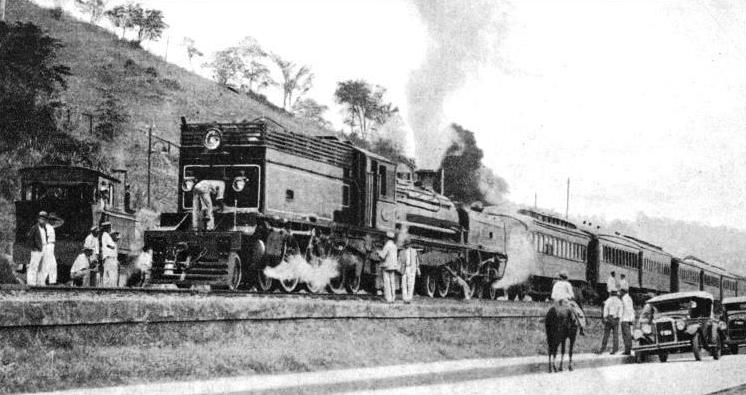
A “BEYER-GARRATT” LOCOMOTIVE built for the Leopoldina Railway. Two of these engines were designed for hauling heavy night passenger trains between Campos and Victoria, a distance of 200 miles. The cylinders measure 15½-in by 22-in, the diameter of the coupled wheels is 4 ft 2-in, the boiler pressure 185 lb per sq in, and the total heating surface 2,032 sq ft. Its coal capacity is 4½ tons, and the water capacity 3,500 gallons. The total weight of one of these engines is 111½ tons.
The total tonnage of goods traffic hauled in 1933 was 1,134,466, and of this figure sugar-cane accounted for 508,260 tons, the next heaviest item being sugar, 197,805 tons. But whereas only £28,933 was received for hauling the sugar-cane, sugar brought in £102,838; while cotton, 27,979 tons, accounted for £29,191. The area served by the railway produces sugar, cotton, and timber, and a considerable quantity of charcoal, of which 23,030 tons carried over the railway was a record figure. Of the total entries of sugar to Pernambuco, the railway carried 62½ per cent, compared with 35 per cent by water and 2½ per cent by road.
The principal workshops are at Jabatao, ten miles from Recife, on the central line of the system, where the heavy repairs are concentrated. The locomotives and the rolling-stock have been built principally in Great Britain. Away to the west, in the heart of the Amazon jungle, is one of the most remarkable railways in the world, the Madeira-Mamore Railway, which is 226 miles in length and connects the towns of São Antonio (Porto Velho being the railway terminus), on the Madeira River, and Guajara-Mirim. It was built to avoid a series of rapids on the Madeira River, and thus to connect 2,000 miles of river navigation on the Madeira and lower Amazon with another 2,000 miles above the rapids, and to afford the Republic of Bolivia an outlet to the Atlantic Ocean. The main rivers of north and north-eastern Bolivia, the Guaporé, the Mamoré, and the Beni flow into the Madeira. The long stretch of rapids and cataracts, extending for 200 miles, was fatal to many of those who ventured in canoes and on rafts to shoot the falls. It was estimated that one-fifth of all the goods were lost during this perilous passage. These losses made the route unprofitable, as the venturesome traders who tried to bring rubber past the rapids had to pay for these losses, and could not compete with people lower down who had not to pass the barrier.
A railway was considered, and attempts were made by American engineers to build a line, but they were defeated by disease. The line had to be abandoned. The great obstacle was the mosquito. It is said that 10,000 men died to build five miles of line and that each sleeper represents the soul of a labourer. Material was brought up the lower Amazon and then up the Madeira as far as the town of São Antonio, where the rapids stopped further navigation. Various attempts were made, each to be defeated by the great loss of life until it seemed that no man could work at such a deadly task.
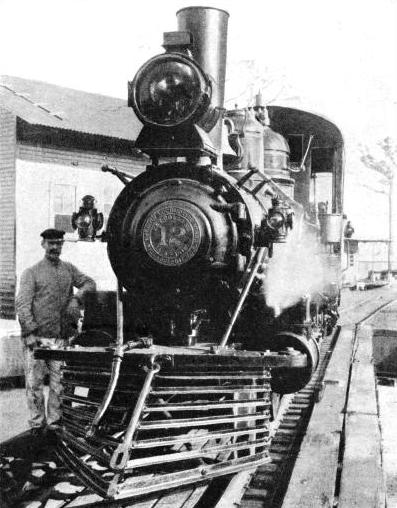
LOST FOR THIRTY YEARS. This locomotive was found abandoned in the jungle where it had been left by pioneers who had perished some thirty years earlier. Several thousand men are reported to have died during the construction of five miles of track in the fever-ridden territory of the lower Amazon.
In 1907, however, Mr. Percival Farquhar, an American, secured a concession which the Brazilian Government had granted the year before to another individual, and the Madeira-Mamoré Railway Company was formed on August 2, 1907. Before starting to build the line the company concentrated on fighting the mosquito. Men found the breeding pools of the insects, and put oil on the water. A staff of doctors supervised all the work of making the district fit for men to live in. A hospital was built, a wireless station was erected and warehouses, offices, and dwellings were put up in what had once been a death-trap. Ships from various parts of the world began steaming up through the waterway that penetrated the mighty forests. In the jungle, abandoned thirty-four years previously by the pioneers of one of the earlier attempts, there was found a locomotive where the men had left it before they staggered away to die. The forest had the locomotive in its clutches; a tree grew from the funnel; vegetation sprouted in the firebox, and insects had made their home in the cab. The discoverers had the derelict hauled to the new depot, where mechanics took it in hand and repaired it. Since then, up to the time of writing, it has been in regular service for nearly a quarter of a century, which is probably a record for a locomotive that was lost for more than thirty years. The cost of building the line was abnormally high, because of the work which had to be done in making the district fit for human beings. By 1919 it had cost about £6,800,000, of which sum the Brazilian Government paid £4,100,000. It was not a profitable undertaking, and in July, 1931, the Brazilian Government took it over. In 1934 it possessed fourteen locomotives, seventeen carriages, and 254 wagons on this metre-gauge railway. Its completion is one of the railway triumphs of the world. Indeed, it may be regarded as an example of the modern progress of science, which has avenged the sacrifice of life in the old days when men had courage but not the knowledge that the present century has acquired. Detached as it is from the rest of the railways of Brazil, and operating in the heart of a wild country, this line is an outstanding example of railway enterprise.
The Central Brazil Railway (Estrada de Ferro Central do Brasil) is the most extensive of the systems owned and operated by the Federal Government, the total length of the lines being 1,903 miles. Of this mileage 1,134 miles are on the metre gauge, 780 miles being on the 5 ft 3-in-. gauge. The discrepancy of eleven miles is due to the fact that parts of the lines are dual gauge - a third rail of the narrow gauge is laid between the broad gauge line, so that trains of both gauges can use them - and these lines have been counted twice over. The broad gauge is that of the original Dom Pedro II Railway, the line which, as we have seen, caused the original Leopoldina Company to find an outlet on the metre gauge to Rio de Janeiro and the sea. The system links Rio de Janeiro city with Bello Horizonte, the capital of the State of Minas Geraes, and also with São Paulo City. the capital of the State of São Paulo, and has a heavy suburban traffic comparable to that of the Leopoldina Railway.
Important Mining Areas
The line to São Paulo is broad gauge and connects the two chief cities of Brazil, for São Paulo has a population of about a million. It stands nearly 3,000 feet above sea-level, the climate being temperate and bracing, and the inhabitants claim that the city and the State are the most enterprising in Brazil. The city is perched up on the Serra, the access to which by the São Paulo Railway from the port of Santos is described in the chapter “A Gateway to Brazil”, beginning on page 515. The central line from Rio de Janeiro into Minas Geraes taps an important mining area. This line is the connecting link between the Leopoldina Railway in the northeast and other systems in the south-west, which together provide rail communication from Victoria to Rio de Janeiro City, São Paulo City, and down to Montevideo, the capital of Uruguay.
The Central Railway has over 200 metre-gauge locomotives, and more than double this number of broad-gauge loco-motives. Metre-gauge wagons number about 2,000, and broad-gauge 5,500.
The Central Railway connects with another important railway, Rêde Mineira de Viacão, which is owned by the Federal Government, but is leased to the State of Minas Geraes, which it serves. The Rêde Mineira system, an amalgamation of several small lines, has a length of 2,350 miles, and is of the metre gauge except for 455 miles, which are 76 cm gauge, or 2 ft 6-in. It is based upon Bello Horizonte, the capital of Minas Geraes, and serves a wide agricultural and mining area. It owns about 300 locomotives, some 275 passenger vehicles and nearly 2,000 goods and livestock vehicles.
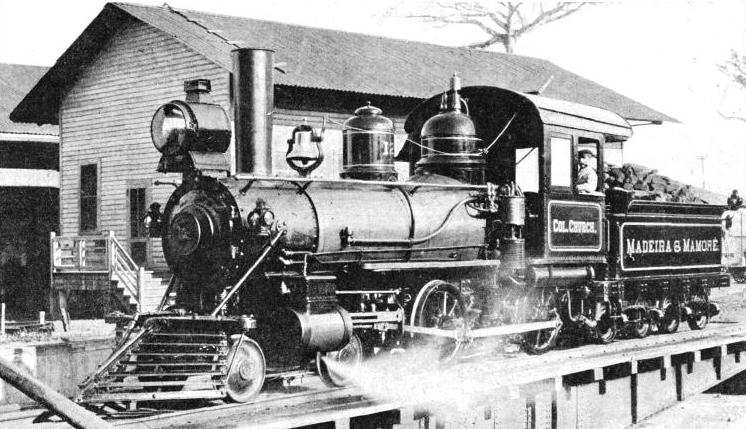
IN SERVICE after having been buried in the jungle for over thirty years. Since its recovery, the engine - seen above after re-conditioning - has given nearly twenty-five years of service on the lines of the Madeira-Mamoré Railway.
The Mogyana Railway Company is also part of this network of lines, as it touches the State of Minas Geraes and operates mainly in that of São Paulo. Except for fifty-two miles of 60 cm gauge, the 1,220 miles of this line are on the metre gauge. It has some 200 locomotives, 300 carriages, and nearly 3,000 wagons. The railway is a privately owned Brazilian one.
Another privately owned railway which connects with this is the Panlista Railway, which also connects with the São Paulo lines. This line is partly electrified. It is 938 miles in length, about half on the 5 ft 3-in gauge, the rest being metre gauge. There are forty-five electric locomotives, 175 steam, 321 carriages, and over 6,000 wagons.
The São Paulo-Rio Grande Railway forms an important link connecting lines in São Paulo with those of the Republic of Uruguay, and has 1,253 miles of metre-gauge track. There are 137 locomotives, 140 carriages and nearly 3,000 wagons. It is owned by the Federal Government.
The Sorocabana Railway Company, which is worked by the State of São Paulo, consists of 1,422 miles of metre-gauge track, links with a number of the railways operating in that State, and extends to the Parana River, which is the boundary of the State of Matto Grosso. The rolling-stock consists of 305 carriages, 4,200 wagons, and there are nearly 300 locomotives.
The Rio Grande do Sul Railway, which is worked by the State of that name, but is owned by the Federal Government, extends from Porto Alegre, the capital of the State, at the head of the extensive Lagoa dos Patos, in a westerly direction to the border of Uruguay. Another line from Rio Grande do Sul, a town at the southern end of the Lagoa dos Patos, joins this first line at Santa Maria. There are 1,683 miles of metre-gauge track, 283 locomotives, 299 carriages, and 3,106 wagons.
The North Western of Brazil Railway, which is owned and operated by the Federal Government, links various lines in the State of São Paulo at Bauru and traverses Brazil in a westerly direction as far as Porto Esperança, on the River Paraguay and close to the frontier of Bolivia.
It thus links the Atlantic seaboard of the States of São Paulo, crosses part of Matto Grosso and readies a great waterway of central South America, for the town of Porto Esperança has a steamer service going upstream to Corumba, the most important commercial town in the State of Matto Grasso, while steamers go downstream to Buenos Aires, the capital of the Argentine Republic. The railway has in locomotives, sixty-one coaches, and 1,220 wagons, and owns 841 miles of metre-gauge track.
Serving Scattered Areas
On the north coast of Brazil, in the State of Ceará, the Ceará Railway (Federal Government) are lines which strike inland from the sea but are not connected laterally. One line extends from Fortaleza (also known as Ceará), which is the capital of the State, and has a population of 136,000, south to Aurora, near the border of Pernambuco State, throwing off branch lines. Away to the west of this railway another line from the port of Camocim leads south to Sobral and Oiticica. There are 842 miles of metre-gauge lines, 102 locomotives, about a hundred passenger vehicles, and 885 wagons.
A larger system, which is operated by a French company for the Federal Government, is that of the Eastern Railways of Brazil, and totals 1,439 miles of metre-gauge lines, 138 locomotives, 197 coaches, and 1,252 wagons. The lines lie between the port of Victoria, the north-eastern extremity of the Leopoldina Railway, and the Great Western of Brazil Railway, which lies to the north-east. The railway serves parts of the States of Sergipe, Bahia, and Minas Geraes.
In addition to the Brazilian railways mentioned in this chapter there are more than thirty minor railways. Indeed, the total number of lines which have separate names is about sixty; they range down to one company which owns two and a half miles of line. The number of railways will, however, indicate the variety and complexity of the great Republic of Brazil. It is not possible to treat such an area as uniform, or to think of railways in terms of standardization, which can be applied in comparatively small countries such as Great Britain, where conditions are settled. It has been estimated that three-quarters of the lines in Brazil were built since the beginning of the century. In recent years progress has been checked by the fall in the exports of coffee, the growth of motor-transport, and by the construction of roads in country where the gradients severely handicap railways.
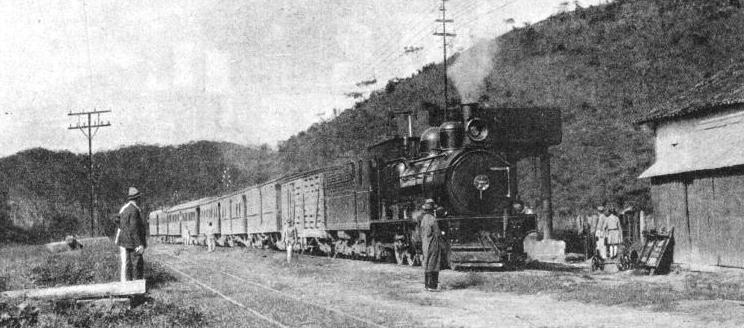
BOUND FOR RIO DE JANEIRO. A passenger train from Campos on the Leopoldina Railway. The railway owns some 300 locomotives, over 480 passenger coaches and about 2,240 goods wagons. The principal freights carried are coffee, sugar, cereals, and timber.
You can read more on “A Gateway to Brazil”, “By Rail in the Argentine” and “The Magic of the Andes” on this website.





 Practice has enabled the operation of these trains, which may be as long as fourteen coaches, to be as nearly perfect as possible. On reaching the foot of the climb each train is split up into sections of two coaches, each section being hauled up by one rack locomotive. Before the train arrives, rack locomotives are waiting on spur lines to pick up their two coaches. Only five minutes are allowed for the work of splitting up the train and getting the coaches on the move.
Practice has enabled the operation of these trains, which may be as long as fourteen coaches, to be as nearly perfect as possible. On reaching the foot of the climb each train is split up into sections of two coaches, each section being hauled up by one rack locomotive. Before the train arrives, rack locomotives are waiting on spur lines to pick up their two coaches. Only five minutes are allowed for the work of splitting up the train and getting the coaches on the move.








